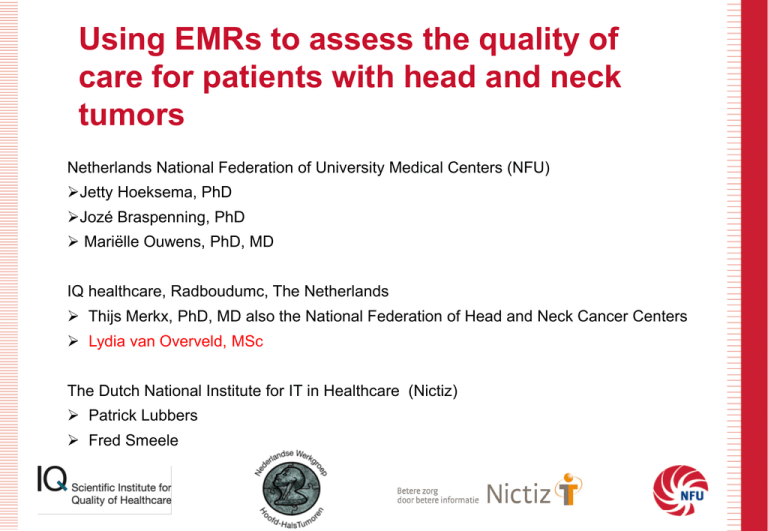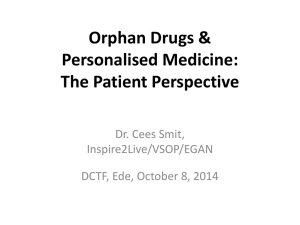drs. Lydia van Overveld (Radboudumc / HHT
advertisement

Using EMRs to assess the quality of care for patients with head and neck tumors Netherlands National Federation of University Medical Centers (NFU) Jetty Hoeksema, PhD Jozé Braspenning, PhD Mariëlle Ouwens, PhD, MD IQ healthcare, Radboudumc, The Netherlands Thijs Merkx, PhD, MD also the National Federation of Head and Neck Cancer Centers Lydia van Overveld, MSc The Dutch National Institute for IT in Healthcare (Nictiz) Patrick Lubbers Fred Smeele Content 1) Patients with head and neck cancer 2) How do we assess the quality of care? 3) To what extent is the information for QI available? 4) To what extent can we use existing building blocks? 5) Conclusions 6) Next steps 1. Patients with head and neck cancer Head and neck cancer 1. Patients with head and neck cancer Alkmaar Enschede (MST) Tilburg (Elisabeth zkh) Content 1) Patients with head and neck cancer 2) How do we assess the quality of care? 3) To what extent is the information for QI available? 4) To what extent can we use existing building blocks? 5) Conclusions 6) Next steps 2. How do we assess the quality of care? Indicators are explicitly defined and measurable items referring to the structures, processes, or outcomes of care input process Improving the quality of health care Research methods used in developing and applying quality indicators in primary care S M Campbell, J Braspenning, A Hutchinson, M N Marshall BMJ, 2003 outcome Andere zorgverlener Diagnosticeren 2e behandeling 1e behandeling Nazorg & follow-up Informeren patiënt & PA uitslag Opname & operatie Chirurgie Bespreking werkgroep of MDO * Vervolg curatief of palliatief? Ontslag Betrekken ondersteunende disciplines voorlopige diagnose Verwijzing huisarts/ tandarts Informeren patiënt & voorlopige diagnose Informeren patiënt & maken masker Informeren patiënt, PA uitslag & (voorlopige) diagnose Poli bezoek preferred partner Bezoek HHOC P4&6 * Diagnost iek Bespreking werkgroep of MDO Gesprek patiënt Poli bezoek HHOC Verwijzing intern of extern specialist Pathologie rapport Vaststellen behandelplan CM aanwezig Intake incl. diagnostiek Curatief Informeer patiënt & Evt. extra diagnostiek & voorbereiden behandeling Opname & behandeling Radioth. * Bespreking werkgroep of MDO Informeren patiënt * Vervolg curatief of palliatief? Ontslag Betrekken ondersteunende disciplines Controle schildklier Informeren patiënt Betrekken ondersteunende disciplines Planning & Chemoth. bestraling Betrekken ondersteunende disciplines Follow-up Bespreking werkgroep of MDO Betrekken ondersteunende disciplines * Vervolg curatief of palliatief? Ontslag Betrekken ondersteunende disciplines Palliatief Informeren patiënt 1e bezoek tot aan afronden diagnostiek Afronden diagnostiek tot aan starten behandeling 1e bezoek tot aan behandeling * = Case mix factor = Medische indicator = Paramedische indicator Blauw = patiënt gericht Groen = acties / betrokken zorgverleners Oranje = optioneel Palliatieve zorg Betrekken ondersteunende disciplines Wachttijd tussen 1e en 2e behandeling Uitkomst 2. How do we assess the quality of care? Developing indicators using Rand modified Delphi method Step 1 Selection of key-recommendations from (inter)national literature & guidelines Step 2 Individual rating by expert panel 1. relevance for prolonging the (disease free) survival 2. relevance for improving quality of life 3. relevance for the quality of the health care process 4. relevance for improving efficiency Step 3 Panel consensus meeting Step 4 Approval final set 2. How do we assess the quality of care? Number of quality indicators Medical Care = 16 area e.g. Outcome indicators (n=3) % cancer recurrence within 5 years Diagnostic indicators (n=6) % patients discussed in MDT Treatment indicators (n=1) % patients seen by a dental team Follow-up indicators (n=2) % patients seen by physiotherapist after neck dissection Coordination and organization (n=4) % start treatment within 28 days 2. How do we assess the quality of care? Number of quality indicators Allied health care worker = 21 area e.g. Outcome indicators (n=3) % cancer recurrence within 5 years Nutritional care (n=3) % malnutrition screening Psychosocial care (n=3) % assessment psychosocial need Dental care (n=3) % muscositis prevention Physical functioning (n=3) % post surgical screening Speech therapy (n=3) % revalidation of swallowing, speech and voice complaints Coordination and organization (n=3) % transmural transfer Structure indicators (n=3) Availability of a casemanager Content 1) Patients with head and neck cancer 2) How do we assess the quality of care? 3) To what extent is the information for QI available? 4) To what extent can we use existing building blocks? 5) Conclusions 6) Next steps 3. To what extent information for QI available? Number of indicators Medical care = 16 Needed variables e.g. General (n= 28)* date of birth; smoker; social status Surgical (n=7) type of surgery; date of surgery Radiotherapy (n= 7) dosis; start Chemotherapy (n= 7) dosis; start Follow-up (n=8) survival; readmissions Pathology report (n= 28) tumor size; tumor classification * Including casemix and identification 3. To what extent information for QI available? Number of indicators Paramedical care = 21 Needed variables e.g. Nutritional care (n=11) loss of weight; BMI Psychosocial care (n=6) assessment date Dental care (n=6) assessment date Physical functioning (n= 9) date preoperative screening Speech therapy (n=5) assessement swallowing problems Follow-up (n=7) aftercare, weight 3. To what extent information for QI available? Referral Intake Diagnostics Treatment Follow-up 1. Not registred 2. Registred in the EMR in any possible way (including free text) 3. Structured registred (means NOT free text) 4. Registred using terminology standards (SNOMED-CT, ICD-10) 3. To what extent information for QI available? Referral Intake Diagnostics Treatment Follow-up Overall conclusion: Analysis is still going on but general conclusion is that most variables are registred but not structured and standardized and not only in EMRs! Sources for variables needed for Quality Indicators EMR’s Primary care process Administrative data Quality registration Quality reports PROM’s PREM’s Content 1) Patients with head and neck cancer 2) How do we assess the quality of care? 3) To what extent is the information for QI available? 4) To what extent can we use existing building blocks? 5) Conclusions 6) Next steps 4. To what extent can we use existing clinical building blocks? Care process Including transfer Research Quality indicators Detailed Clinical Models = Klinische Bouwstenen (GENOEG = Generieke overdrachtsgegevens) - Based upon CCR (Continuity of Care Record) structure - SNOMED coded where possible - Finished and first published, 2013 (v1.0) - 40 medical, 40 nursing - Implementation for transfer into C-CDA (HL7) HartslagRegelmatigheidCodelijst OID: 2.16.840.1.113883.2.4.3.11.60.40.2.12.3.1 Concept Name Concept Code Coding Syst. Name Coding System OID Description Regular 271636001 SNOMED CT 2.16.840.1.113883.6.96 regelmatige polsslag Irregular 61086009 SNOMED CT 2.16.840.1.113883.6.96 onregelmatige polsslag heartrate CCR/CCD Header Sectie 1 – Payers Sectie 2 – Advance Directives Sectie 3 – Support Sectie 4 – Functional Status Sectie 5 – Problems Sectie 6 – Family History Sectie 7 – Social History Sectie 8 – Alerts Sectie 9 – Medications Sectie 10 – Medical Equipement Sectie 11 – Immunizations Sectie 12 – Vital Signs Sectie 13 – Results Sectie 14 – Procedures Sectie 15 – Encounters Sectie 16 – Plan of Care Sectie 17 – Healthcare Providers Klinische bouwsteen OverdrachtPatient OverdrachtZorgaanbieder OverdrachtZorgverlener OverdrachtBetaler OverdrachtBehandelAanwijzing OverdrachtContactpersoon OverdrachtFunctioneleStatus OverdrachtBartheIndex OverdrachtProbleem OverdrachtFamilieanamnese OverdrachtBurgerlijkeStaat OverdrachtDrugsgebruik OverdrachtIntoxicatieAlcohol OverdrachtIntoxicatieTabak OverdrachtLevensovertuiging OverdrachtNationaliteit OverdrachtOpleiding OverdrachtWoonsituatie OverdrachtAlert OverdrachtMedicatie OverdrachtMedischeHulpmiddel OverdrachtVaccinatie OverdrachtAdemfrequentie OverdrachtBloeddruk OverdrachtGewicht OverdrachtGlasgowComaScale OverdrachtHartfrequentie OverdrachtLengte OverdrachtO2Saturatie OverdrachtPijnscore OverdrachtPolsfrequentie OverdrachtTemperatuur OverdrachtLabUitslag OverdrachtTekstUitslag OverdrachtProcedure OverdrachtContact OverdrachtPlanOfCare OverdrachtZorgverlener Standards used Standaard Registratie ICD-10 Classificatie medische diagnose ICD-O-3 Classificatie oncologische diagnose SNOMED-CT Codering medische gegevens (C/P/R) TNM Stadiering tumor ACE-27 Specifieke oncologische comorbiditeit VAS Classificatie van pijnscores CTC/RTOG Classificatie oncologische toxiciteiten Karnofsky Classificatie functionele toestand patiënt Specific information elements and available building blocks Informatie-element (mid-level) Voorgeschiedenis Anamnese – algemeen Anamnese – familie Anamnese – sociaal Lichamelijk onderzoek – algemeen Lichamelijk onderzoek – gewicht Lichamelijk onderzoek – eetgewoonte Intoxicaties – alcohol Intoxicaties – drugs Intoxicaties – roken Allergieën Medicatie Comorbiditeit Tumor Metastasering Behandeling Complicaties Toxiciteit Pijnscore(VAS) Lab bepalingen MDO Klinische bouwsteen beschikbaar? Ja, OverdrachtProbleem Ja, OverdrachtProbleem Ja, OverdrachtFamilieanamnese Ja, OverdrachtWoonsituatie Nee, maar in ontwikkeling Ja, OverdrachtGewicht Nee, maar in ontwikkeling Ja, OverdrachtIntoxicatieAlcohol Ja, OverdrachtDrugsgebruik Ja, OverdrachtIntoxicatieTabak Ja, OverdrachtAlert Ja, OverdrachtMedicatie Ja, OverdrachtProbleem Nee Nee Ja, OverdrachtProcedure Ja, OverdrachtProbleem Nee Ja, OverdrachtPijnscore Ja, OverdrachtLabUitslag Nee 4. To what extent can we use existing clinical building blocks? Results careproces patients with Head and Neck Cancer 1. Directly useful (e.g. CBB Weight) 2. Useful with modification (e.g. CBB Plan of care) 3. No CBB available (e.g. MDT and Tumor classification) Content 1) Patients with head and neck cancer 2) How do we assess the quality of care? 3) To what extent is the information for QI available? 4) To what extent can we use existing building blocks? 5) Conclusions 6) Next steps 5. Conclusions en next steps Using EMRs to assess the quality of care for patients with head and neck tumors Therefore…… - We developed quality indicators - We verified if the variables or information pieces needed to measure the QI were available - We checked if we could use the existing building blocks 5. Conclusions Quality indicators need far more information elements than minimal necessary for the care process. Most information elements (or variables) needed for Quality indicators in EMRs is unstructured and not standardized (e.g. Snomed CT) Standardized registration needs to be improved. A discussion is needed about which variables should be registred in EMRs for both the care process as quality indicators (if not than less indicators!) Quality Indicators HNC Less indicators Information needed from Administration Patients (QoL,Proms) EMRs structured and standardized (Snomed CT e.g ) If not in EMRs Register in EMRs Content 1) Patients with head and neck cancer 2) How do we assess the quality of care? 3) To what extent is the information for QI available? 4) To what extent can we use existing building blocks? 5) Conclusions 6) Next steps 6. Next steps New Clinical Building Blocs will be developed f.e. MultiDisciplinary Team meetings and Tumor classification, By specifications of existing blocs By creating complete new blocs Test in practice which information elements can directly be extracted form EMRs Process evaluation of the usefulnes of the building blocs in general More information www.nfu.nl www.nictiz.nl E-mail: Lydia.vanOverveld@radboudumc.nl Marielle.Ouwens@radboudumc.nl









